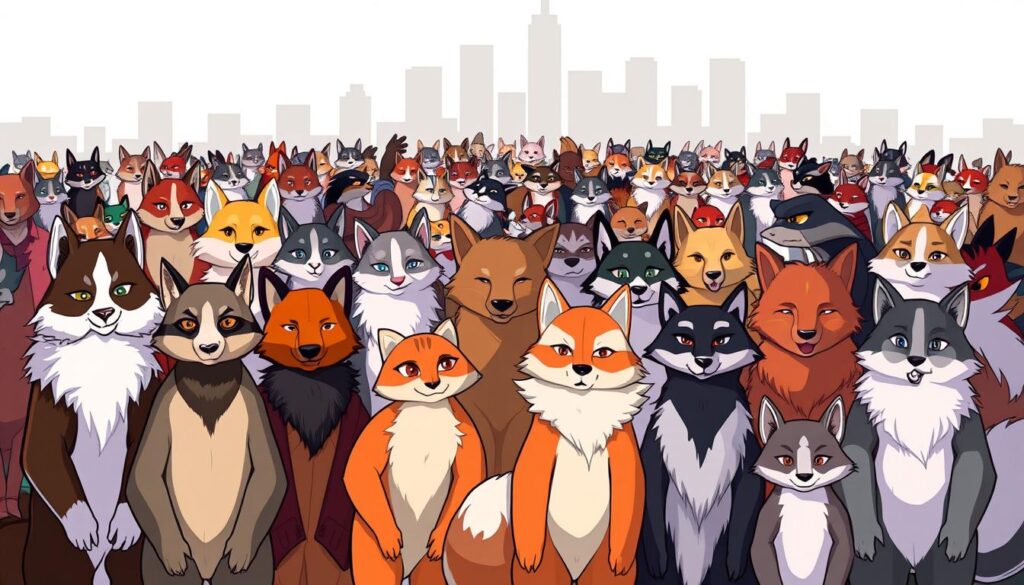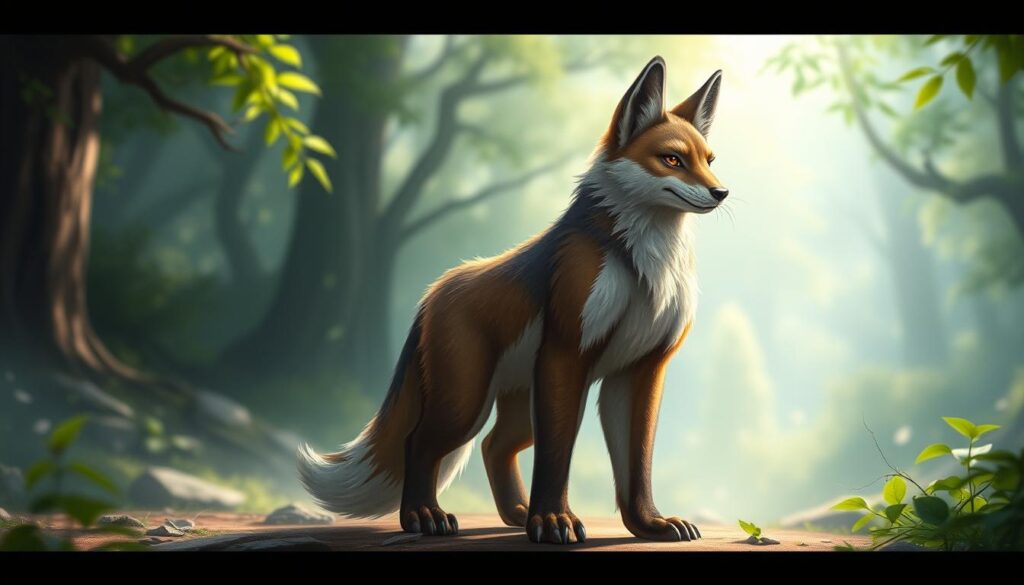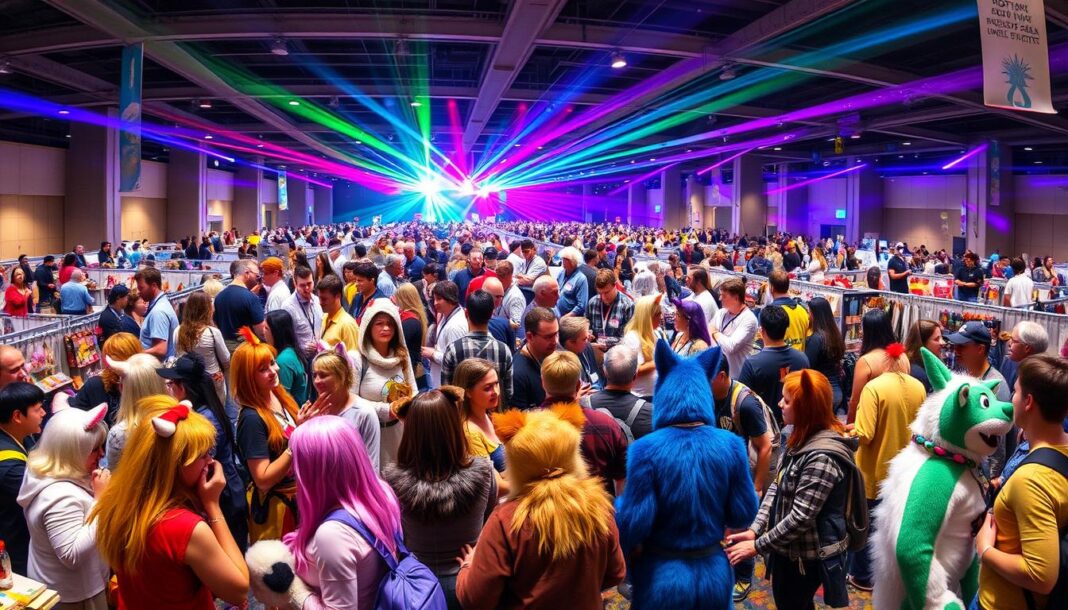The furry community is a vibrant and diverse group, with a global presence that’s hard to ignore. Estimates suggest that there are between one and three million furries worldwide, but getting an accurate count is challenging due to the lack of official records and the dispersed nature of the fandom.
Many furries participate anonymously online or may not attend conventions, making it difficult to obtain accurate numbers. According to research, the furry population could be in the hundreds of thousands, with some estimates suggesting a presence in North America, Europe, and increasingly in Asia, as noted by the International Anthropomorphic Research Project.
We’ll delve into the fascinating world of the furry fandom, exploring the various data sources that help us understand its scope, from convention attendance to online forum participation.
What Defines the Furry Fandom
As we delve into the world of furries, it’s essential to understand the roots and characteristics that define this unique fandom. The furry community is built around a shared interest in anthropomorphic characters, which are animals with human-like qualities.
Origins and Evolution of Furry Culture
The furry fandom began to take shape in the 1980s, emerging from science fiction and comic book conventions where fans of anthropomorphic characters gathered. The roots of furry culture can be traced back to underground comic publishing in the 1970s and 1980s. The 1973 animated film Robin Hood also played a significant role in shaping the aesthetic of the furry fandom. The introduction of the internet in the 1990s was a crucial factor in the growth and global connectivity of the furry community. As a result, the fandom evolved beyond geographical limitations, allowing furries to connect, share, and create content on a global scale. This evolution is a testament to the power of the internet in fosteringcommunityandculture.
The furry fandom is not just about consuming existing media; it’s a “producer fandom” where members create their own content, including art, stories, and characters. This creative aspect is a defining characteristic of the furry community. For instance, the creation of fursonas – personalized animal characters that represent individuals within the fandom – is a key aspect of furry identity. You can explore more about the creative expressions within the furry fandom, such as thelong furby experience, which highlights the unique aspects of furry culture.
Key Characteristics of the Furry Community
The furry community is characterized by its creativity, inclusivity, and passion for anthropomorphic characters. Furries engage in various activities, including creating and sharing art, writing stories, and participating in role-playing games. The community has developed its own traditions, language, and creative expressions over time. For example, the appreciation of anthropomorphic art is a common thread among furries, with many artists within the community creating stunning works that reflect their fursonas and the broader furry culture. The furry fandom is a vibrant and diverse community that continues to grow and evolve.
By understanding the origins, evolution, and key characteristics of the furry fandom, we can gain a deeper appreciation for this unique and creative community.
The Challenge of Counting Furries
Counting furries globally is challenging, and researchers face several obstacles. The furry community is diverse and widespread, making it difficult to gather accurate data. One of the primary challenges is the lack of centralized registration or membership within the fandom.
Several factors contribute to the complexity of estimating the number of furries. We will explore these challenges in detail.
Privacy Concerns and Anonymous Participation
Many furries value their privacy and choose to remain anonymous, especially when it comes to their involvement in the community. This anonymity makes it difficult for researchers to gather accurate information. Some furries may not be “out” to their family, friends, or employers, either as queer individuals or as furries, or both. As a result, they may be hesitant to participate in surveys or research studies, further complicating data collection.
The issue of privacy is particularly significant in online spaces where furries interact. Anonymous participation is common, and this anonymity can create additional challenges for researchers attempting to quantify the community’s size.
Varying Levels of Involvement in the Fandom
The fandom encompasses a wide range of involvement, from casual fans to deeply committed community members. This variability makes it challenging to define who should be counted as a furry. Some individuals may identify as furries but not actively participate in groups or events, while others may be heavily involved in various aspects of the community.
For instance, a person might enjoy Furby-related content or participate in online forums, but not consider themselves a part of the furry fandom. Others might be deeply invested in creating art, writing stories, or attending conventions related to the furry community. This spectrum of involvement complicates efforts to determine the exact number of furries.
These challenges have led to a wide range of estimates regarding the global furry population, with numbers varying from 100,000 to over a million. The variability in these estimates underscores the need for more nuanced research approaches that can account for the complexities within the furry community.
Current Estimates: How Many Furries Are in the World
Several studies have endeavored to estimate the global furry population, yielding a range of figures that provide insight into this unique community. The furry fandom, known for its creativity and diversity, has grown significantly over the years, making it a subject of interest for researchers and enthusiasts alike.
Research-Based Population Figures
Research groups like FurScience have conducted extensive surveys to estimate the size of the furry community. According to their data, the furry population is estimated to be in the hundreds of thousands worldwide. Other studies suggest similar numbers, although precise figures are hard to pin down. Estimates suggest that there are somewhere between one and three million furries worldwide.
Different methodologies have been used to arrive at these population figures, each with its strengths and limitations. For instance, surveys conducted at furry conventions and online forums provide valuable data, but may not capture the entire community. Comparing these methodologies helps in understanding the number of furries more accurately.
- Surveys and studies provide estimates ranging from hundreds of thousands to a few million furries globally.
- The use of online platforms has expanded the community, making it easier for furries to connect and participate.
- Convention attendance numbers have seen a significant increase, indicating growth in the community.
Growth Trends in the Furry Community
The furry community has experienced substantial growth over the past few decades. From its small beginnings to the current size, the fandom has evolved significantly. The growth trends indicate a steady increase in the number of furries, with online platforms playing a crucial role in this expansion.
Analyzing the growth trends involves looking at various factors, including convention attendance and online engagement. The rise in community participation, both online and offline, suggests that the fandom is continuing to grow. As new generations discover the furry fandom, it’s likely that this trend will continue.
By comparing the size of the furry community to other fandoms and interest groups, we can better understand its relative scale and significance. The data and research provide a foundation for understanding the world of furries and their number in the global community.
Furry Demographics: Who Makes Up the Fandom
Exploring the demographic makeup of furries provides insight into the community’s values and culture. The furry fandom is a diverse group, comprising individuals from various age groups, gender identities, and sexual orientations.
Age Distribution
The age distribution among furries shows that most are young adults under 25, bringing new energy to the fandom. Many join the community during their teenage years, drawn by the creative expression and social connections it offers.
Gender Identity
Looking at gender identity within the furry community, we find a diverse range of identities. While 73.2% of furries identify as male, there’s a significant presence of transgender and non-binary individuals, each making up 12.5% of the community. This diversity highlights the fandom’s inclusive nature.
Sexual Orientation and Diversity
The furry fandom is welcoming to all sexual orientations. According to surveys, 28.8% of furries identify as lesbian, gay, or homosexual, and 23.4% as bisexual. Over 70% of furries are part of the LGBTQ+ community, confirming the fandom’s role as a safe space for self-expression.
To better understand the demographics, let’s look at some key statistics in a tabular form:
| Demographic Category | Percentage |
|---|---|
| Male | 73.2% |
| Transgender | 12.5% |
| Non-binary | 12.5% |
| LGBTQ+ | 70% |
| Lesbian, Gay, or Homosexual | 28.8% |
| Bisexual | 23.4% |

The demographic characteristics of the furry community influence its culture, values, and growth patterns. The prevalence of young adults and the significant representation of LGBTQ+ individuals contribute to the fandom’s vibrant and inclusive atmosphere.
Global Distribution of Furries
The distribution of furries across the globe is a fascinating topic, revealing the community’s diversity and reach. As we explore the global furry landscape, we find that the community is not confined to a specific region but is instead spread across various countries and continents.
North American Furry Population
North America, particularly the United States, is home to one of the largest furry populations. The region hosts major conventions like Anthrocon and has a strong online presence, contributing to its significant furry community. Estimates suggest that tens of thousands of furries are active in this region.
European Furry Communities
Europe also boasts a substantial furry population, with countries like Germany, the UK, and France hosting large conventions and maintaining active online communities. These European furry communities have developed their own distinctive subcultures, enriching the global furry fandom.
Furries in Asia and Other Regions
While the furry community is smaller in Asia compared to North America and Europe, it is growing steadily. Countries like Japan and China are witnessing emerging furry scenes, with conventions and online groups gaining traction. Other regions, including Australia and South America, also have active furry communities, albeit on a smaller scale.
| Region | Furry Community Size | Notable Activities |
|---|---|---|
| North America | Tens of thousands | Major conventions like Anthrocon |
| Europe | Significant presence | Large conventions in Germany, UK, and France |
| Asia | Growing community | Emerging conventions in Japan and China |
Furry Conventions as Population Indicators
Furry conventions have become a cornerstone of the fandom, offering a unique lens through which to gauge the community’s size and growth. These events are not just gatherings; they are significant indicators of the fandom’s overall health and popularity.
Some of the largest and most notable furry conventions include Anthrocon in the United States, Eurofurence in Germany, and Midwest FurFest. These conventions attract thousands of attendees each year, providing a tangible measure of the fandom’s scale.
Major Conventions and Attendance Numbers
Major furry conventions have seen substantial attendance numbers. For example, Anthrocon, one of the largest furry conventions, has grown from around 500 participants in the late 1990s to over 9,000 in recent years. Similarly, other conventions like Midwest FurFest and Eurofurence have also experienced significant growth, with attendance figures reflecting the overall expansion of the furry community.
The attendance at these conventions is a strong indicator of the fandom’s size. By analyzing the growth trends in convention attendance, we can infer the overall growth of the furry population. The increasing attendance is not limited to a single region; it’s a global phenomenon, with conventions worldwide reporting higher numbers year after year.
Convention Growth as a Metric for Fandom Size
The growth in convention attendance serves as a valuable metric for estimating the size of the furry fandom. As conventions continue to grow in popularity and attendance, it suggests that the community is expanding. For instance, Anthrocon’s expansion from 500 attendees to over 9,000 is a clear indicator of the fandom’s growth over the years.
By examining the percentage of the total furry population that attends these conventions, we can make more informed estimates about the overall community size. While not all furries attend conventions, the consistent increase in attendance numbers provides a reliable indicator of the fandom’s overall trend.
Furthermore, the evolution of conventions from small gatherings to major events requiring substantial infrastructure and planning underscores the fandom’s growth. Convention attendance data, when used alongside other metrics, can help create more accurate estimates of the global furry population.
Online Presence: Digital Furry Communities
The digital footprint of the furry community is substantial, with various online spaces contributing to its growth. The community has a strong online presence, with large groups on platforms like Reddit, Twitter, and dedicated forums such as Fur Affinity.
These platforms provide a rough estimate of the community’s size, with tens of thousands of active users engaging daily. The growth of online spaces has significantly contributed to the visibility and expansion of the fandom.
Social Media and Forum Participation
Social media platforms have become essential for furry community building and expression. Dedicated groups and hashtags on platforms like Twitter and Reddit host a vast amount of furry content, facilitating interaction among community members.
For instance, Fur Affinity, a dedicated furry forum, has hundreds of thousands of registered users and hosts millions of pieces of furry artwork. This level of engagement indicates a thriving online community.
| Platform | User Engagement | Content Type |
|---|---|---|
| Tens of thousands of active users | Discussions, Art, Stories | |
| Thousands of daily interactions | Art, Updates, Discussions | |
| Fur Affinity | Hundreds of thousands of registered users | Artwork, Profiles, Forums |
Digital Art Platforms and Furry Content
Digital art platforms have become central to furry culture, with many artists sharing their work online. Metrics from these sites can help estimate community size and activity levels.
The furry community’s online activity is not limited to content creation; it also involves significant interaction through comments, likes, and shares. This level of engagement underscores the community’s vibrancy and its reliance on digital platforms.
By examining the furry community’s online presence, we can gain insights into its size, demographics, and level of engagement. The community’s digital footprint is a crucial aspect of its overall identity and growth.
Fursonas: The Heart of Furry Identity
Fursonas are personalized animal characters that have become a cornerstone of the furry fandom, allowing individuals to express themselves in unique ways. About 95% of furry community members enjoy making a unique fursona as their avatar. This creative expression is not just about picking an animal; it’s a deep form of self-expression that reflects the individual’s personality, traits, or aspirations.

Species Significance
The wolf, dragon, and fox are among the most popular fursona species. Wolves are often chosen for their pack loyalty, symbolizing companionship and fidelity. Dragons represent power and wisdom, traits that many in the furry community admire or aspire to. Foxes, known for their cleverness, are also a favorite among furries. These animals are not just liked for their characteristics; they are often seen as embodying traits that fans relate to or wish to have.
The choice of a fursona species can reveal a lot about an individual’s personality or aspirations. For instance, someone who identifies with a wolf may value loyalty and community, while a dragon fursona might indicate a desire for power or wisdom. This connection between the fursona and the individual’s identity is a crucial aspect of the furry culture.
Personal Expression and Identity
Creating a fursona is a personal and often emotional process. It’s a way for individuals to explore their identity and express themselves in a manner that might not be possible in everyday life. The process of designing a fursona allows furries to embody traits they admire or aspire to develop, serving as a form of personal growth and self-reflection.
For many, their fursona evolves over time, reflecting changes in their self-perception or personal growth. This evolution is a natural part of the furry journey, as individuals continue to explore and express their identities through their fursonas. The fursona is not just a character; it’s an extension of the person, a representation of their inner self, and a means to connect with like-minded individuals within the community.
Fursuits: Bringing Fursonas to Life
Bringing fursonas to life, fursuits are a cherished aspect of furry culture, showcasing the artistry and craftsmanship of the community. These elaborate costumes are more than just attire; they are a physical manifestation of a furry’s identity and creativity.
Fursuits are worn proudly at community events and gatherings, serving as a visual representation of the furry fandom’s diversity and vibrancy. While not all furries own a fursuit, those who do often consider it a significant part of their participation in the community.
Ownership Statistics
Research indicates that approximately 15-25% of furries own a fursuit, though this percentage can vary based on the community segment and level of involvement. This relatively low percentage is largely due to the high cost and complexity associated with creating a fursuit.
The decision to own a fursuit often correlates with the level of involvement in the furry community. More active participants are more likely to invest in a fursuit as a means of deeper engagement and self-expression.
| Fursuit Ownership | Percentage of Furries | Community Involvement Level |
|---|---|---|
| Own a Fursuit | 15-25% | High |
| Do Not Own a Fursuit | 75-85% | Varied |
The Cost of Creativity
The economics of fursuit creation are significant, with professional suits often costing thousands of dollars. Top-tier fursuit makers are in high demand, frequently having waiting lists that stretch for years.
Despite the cost, the craftsmanship involved in creating fursuits has developed into a niche industry within the furry community. Fursuit makers range from hobbyists to professionals, each bringing their unique style and skill to their creations.
The variation in fursuit quality and price allows furries to choose a suit that fits their budget and preferences. Whether a fursuit is homemade or professionally made, it represents a personal expression of the owner’s fursona and identity.
In conclusion, fursuits are a vital part of the furry culture, representing creativity, identity, and community involvement. While they may be expensive and not owned by the majority, their significance within the fandom is undeniable.
Common Misconceptions About Furry Numbers
The true size and characteristics of the furry fandom are frequently obscured by misconceptions. These misconceptions not only affect public perception but also impact research efforts to understand the community accurately.
Historically, media coverage of the furry fandom has veered between outrage and fascination, often focusing on sensational aspects. For instance, a 2008 Vanity Fair piece titled “Pleasures of the Fur: the Animalistic, Sexy World of Furries” set a tone that subsequent coverage followed. This kind of reporting has contributed significantly to the public’s misconceptions about the fandom.
Media Portrayals vs. Reality
Media portrayals have often exaggerated or distorted aspects of furry culture, creating false impressions about who furries are and how many there might be. For example, an episode of CSI: Miami portrayed furries as a crazed zoophiliac cult, further perpetuating negative stereotypes. In reality, the furry fandom is characterized more by art, cosplay, and a philosophy of radical acceptance than by the sexual elements that media often highlight.
Debunking Myths About the Fandom Size
Myths about the size of the furry community abound, ranging from underestimations that dismiss it as a tiny fringe group to overestimations that exaggerate its presence. To understand the true size and nature of the fandom, it’s essential to look at research-based estimates and growth trends. For more insights on how to engage with the furry fandom, you can visit this page for related information.
By examining the available data and understanding the impact of media portrayals, we can work towards a more accurate perception of the furry fandom and its size.
The Economic Impact of the Furry Community
The furry community’s economic impact is multifaceted, involving various aspects such as art, conventions, and charity work. This diverse fandom contributes significantly to the economy through different channels.
The community’s love for art is a major driver of economic activity. Around 85% of furries buy content regularly, spending an average of $881.74 each on digital art. This creates a thriving market for furry art commissions, where artists can earn substantial incomes creating custom artwork for community members.
Art Commissions and Digital Content
The demand for furry art is high, with many artists making a living from creating digital content. This not only benefits the artists but also contributes to the overall economic activity within the community.
| Category | Average Spend | Percentage of Community |
|---|---|---|
| Digital Art | $881.74 | 85% |
| Fursuits | Varies | Percentage who own |
| Convention Attendance | Average $200-$500 | Regular attendees |
Convention Revenue and Local Economic Benefits
Furry conventions are another significant source of economic impact. These events generate millions in revenue, not just for event organizers but also for local economies through hotel bookings, restaurant visits, and tourism. The community’s charitable efforts also add to its positive economic and social footprint.
By examining the economic activities within the furry community, we gain a deeper understanding of its size and commitment level. The community’s economic impact is a testament to its vitality and the strong bonds among its members.
The Future Growth of the Furry Fandom
With growing social acceptance and technological advancements, the furry fandom is expected to thrive. As more people discover the fandom and find a place within it, the number of furries worldwide is likely to rise.
The expansion of online spaces and improved online communication tools will continue to enhance community engagement. Additionally, positive media portrayal and greater societal acceptance of diverse interests and identities will likely support the growth of furry culture.
Technological advancements, such as virtual reality and digital art tools, might shape the future of the community, allowing people to express their animal characters in new and innovative ways. As a result, being part of the furry world will become an integral part of their life.


